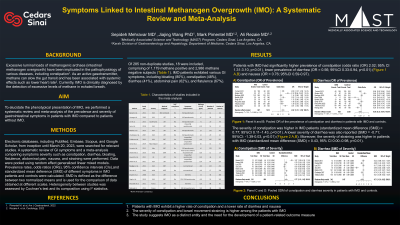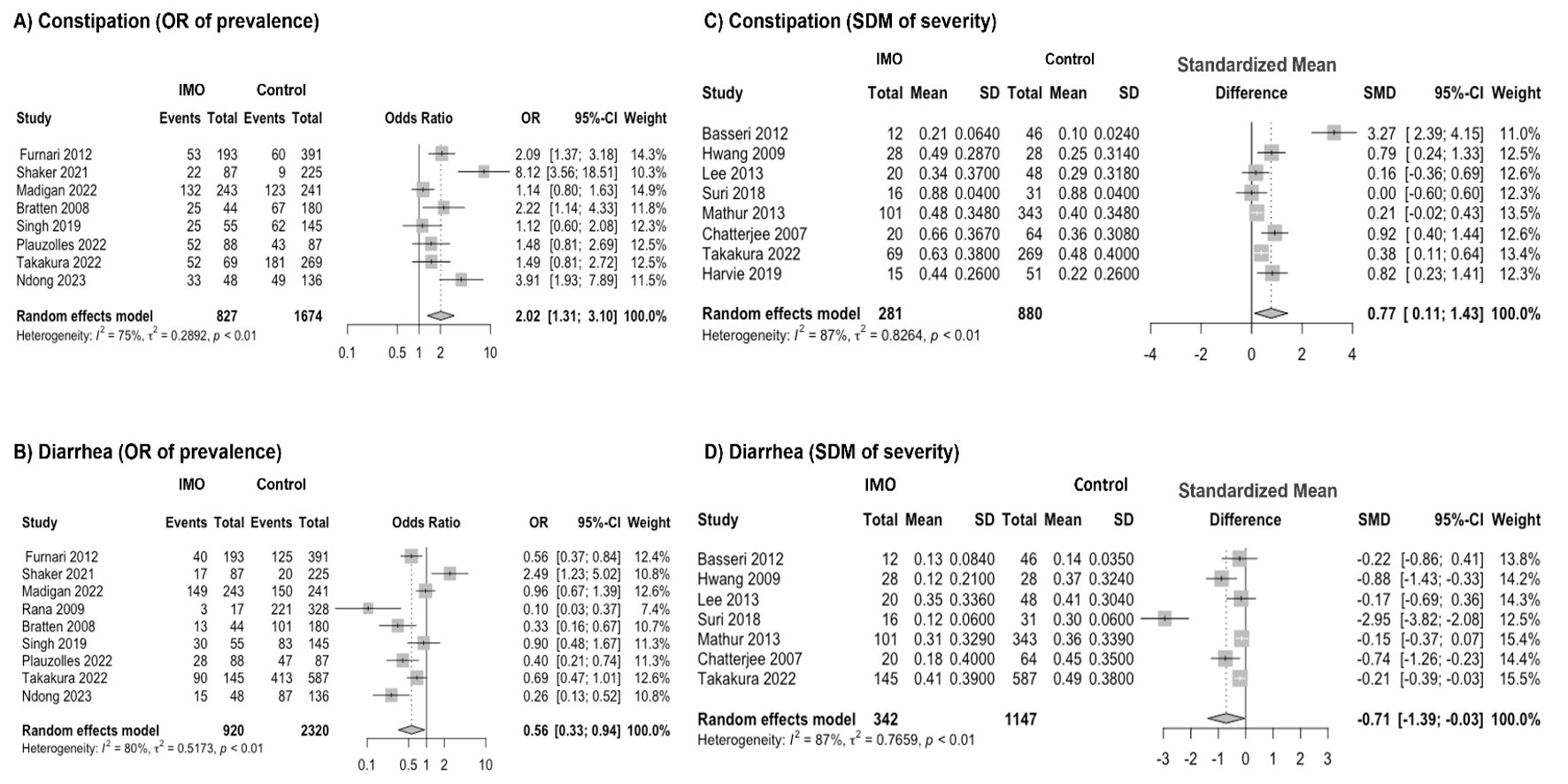Monday Poster Session
Category: Functional Bowel Disease
P1957 - Symptoms Linked to Intestinal Methanogen Overgrowth (IMO): A Systematic Review and Meta-Analysis
Monday, October 23, 2023
10:30 AM - 4:15 PM PT
Location: Exhibit Hall

Has Audio

Sepideh Mehravar, MD
Cedars-Sinai Medical Center
West Hollywood, California
Presenting Author(s)
Sepideh Mehravar, MD1, Jiajing Wang, PhD1, Ali Rezaie, MD, MSc, FRCPC2, Mark Pimentel, MD, FACG1
1Cedars-Sinai Medical Center, West Hollywood, CA; 2Cedars-Sinai Medical Center, Beverly Hills, CA
Introduction: Excessive luminal loads of methanogenic archaea (intestinal methanogen overgrowth) have been implicated in the pathophysiology of various diseases, including constipation. As an active gasotransmitter, methane can slow the gut transit and has even been associated with systemic effects such as lower heart rate. Currently, IMO is clinically diagnosed by the detection of excessive levels of methane in exhaled breath. To elucidate the phenotypical presentation of IMO, we performed a systematic review and meta-analysis of the prevalence and severity of gastrointestinal symptoms in IMO as compared to patients without IMO.
Methods: Electronic databases, including PubMed, Embase, Scopus, and Google Scholar, from inception until March 20, 2023, were searched for relevant studies. A systematic review of GI symptoms and a meta-analysis comparing symptoms severity such as constipation, diarrhea, bloating, flatulence, abdominal pain, nausea, and straining were performed. Data were pooled using random effect generalized linear mixed models. Prevalence rates, odds ratios (ORs), and 95% confidence intervals (CIs) of different symptoms in IMO patients and controls were calculated. Heterogeneity between studies was assessed by Cochran's test and its composition using I2 statistics.
Results: Of 285 non-duplicate studies, 18 were included, comprising 1179 methane positive and 2986 methane negative (Table 1). IMO patients exhibited various GI symptoms, including bloating (80%), constipation (48%), diarrhea (41%), abdominal pain (62%), and flatulence (67%). Patients with IMO had a significantly higher prevalence of constipation (odds ratio (OR) 2.02; 95% CI 1.31-3.10, p< 0.01), lower prevalence of diarrhea (OR = 0.56; 95% CI 0.33-0.94, p< 0.01) and nausea (OR = 0.76; 95% CI 0.59-0.97). The severity of constipation and straining were higher in IMO patients (standardized mean difference (SMD) = 0.77, 95% CI 0.11–1.43) and (SMD = 0.43, 95% CI 0.00–0.98), respectively. A lower severity of diarrhea was also reported (OR = -0.71, 95% CI: -1.39- -0.03) (Figure 1).
Discussion: IMO patients exhibit a higher rate and severity of constipation and lower rate and severity of diarrhea. Distinct phenotype of IMO patients should be further studied and correlated with mechanistic microbiome studies.

Disclosures:
Sepideh Mehravar, MD1, Jiajing Wang, PhD1, Ali Rezaie, MD, MSc, FRCPC2, Mark Pimentel, MD, FACG1. P1957 - Symptoms Linked to Intestinal Methanogen Overgrowth (IMO): A Systematic Review and Meta-Analysis, ACG 2023 Annual Scientific Meeting Abstracts. Vancouver, BC, Canada: American College of Gastroenterology.
1Cedars-Sinai Medical Center, West Hollywood, CA; 2Cedars-Sinai Medical Center, Beverly Hills, CA
Introduction: Excessive luminal loads of methanogenic archaea (intestinal methanogen overgrowth) have been implicated in the pathophysiology of various diseases, including constipation. As an active gasotransmitter, methane can slow the gut transit and has even been associated with systemic effects such as lower heart rate. Currently, IMO is clinically diagnosed by the detection of excessive levels of methane in exhaled breath. To elucidate the phenotypical presentation of IMO, we performed a systematic review and meta-analysis of the prevalence and severity of gastrointestinal symptoms in IMO as compared to patients without IMO.
Methods: Electronic databases, including PubMed, Embase, Scopus, and Google Scholar, from inception until March 20, 2023, were searched for relevant studies. A systematic review of GI symptoms and a meta-analysis comparing symptoms severity such as constipation, diarrhea, bloating, flatulence, abdominal pain, nausea, and straining were performed. Data were pooled using random effect generalized linear mixed models. Prevalence rates, odds ratios (ORs), and 95% confidence intervals (CIs) of different symptoms in IMO patients and controls were calculated. Heterogeneity between studies was assessed by Cochran's test and its composition using I2 statistics.
Results: Of 285 non-duplicate studies, 18 were included, comprising 1179 methane positive and 2986 methane negative (Table 1). IMO patients exhibited various GI symptoms, including bloating (80%), constipation (48%), diarrhea (41%), abdominal pain (62%), and flatulence (67%). Patients with IMO had a significantly higher prevalence of constipation (odds ratio (OR) 2.02; 95% CI 1.31-3.10, p< 0.01), lower prevalence of diarrhea (OR = 0.56; 95% CI 0.33-0.94, p< 0.01) and nausea (OR = 0.76; 95% CI 0.59-0.97). The severity of constipation and straining were higher in IMO patients (standardized mean difference (SMD) = 0.77, 95% CI 0.11–1.43) and (SMD = 0.43, 95% CI 0.00–0.98), respectively. A lower severity of diarrhea was also reported (OR = -0.71, 95% CI: -1.39- -0.03) (Figure 1).
Discussion: IMO patients exhibit a higher rate and severity of constipation and lower rate and severity of diarrhea. Distinct phenotype of IMO patients should be further studied and correlated with mechanistic microbiome studies.

Figure: Figure 1
Panel A and B: Pooled odds ratios of the prevalence of constipation and diarrhea in patients with IMO and controls. Panel C and D: Pooled SDM of constipation and diarrhea severity in patients with IMO and controls.
Panel A and B: Pooled odds ratios of the prevalence of constipation and diarrhea in patients with IMO and controls. Panel C and D: Pooled SDM of constipation and diarrhea severity in patients with IMO and controls.
Disclosures:
Sepideh Mehravar indicated no relevant financial relationships.
Jiajing Wang indicated no relevant financial relationships.
Ali Rezaie: Ardelyx – Consultant. Bausch Health – Advisory Committee/Board Member, Speakers Bureau. Gemelli Biotech – Intellectual Property/Patents, Owner/Ownership Interest. GoodLFE – Owner/Ownership Interest.
Mark Pimentel: 9meters – Grant/Research Support, Cedars-Sinai has a licensing agreement with 9meters, Stock Options. Aytu Biosciences – Cedars-Sinai has a licensing agreement with Aytu Biosciences. Bausch Health – Grant/Research Support, Former consultant. Dieta Health – Consultant, Stock Options. Ferring Pharmaceuticals Inc – Consultant. Gemelli Biotech – Cedars-Sinai has a licensing agreement with Gemelli Biotech, Stock Options. Hobbs Medical – Cedars-Sinai has a licensing agreement with Hobbs Medical. Salvo Health – Consultant, Stock Options. Synthetic Biologics (now Theriva) – Grant/Research Support, Stock Options. Vivante Health Inc. – Consultant, Stock Options.
Sepideh Mehravar, MD1, Jiajing Wang, PhD1, Ali Rezaie, MD, MSc, FRCPC2, Mark Pimentel, MD, FACG1. P1957 - Symptoms Linked to Intestinal Methanogen Overgrowth (IMO): A Systematic Review and Meta-Analysis, ACG 2023 Annual Scientific Meeting Abstracts. Vancouver, BC, Canada: American College of Gastroenterology.
